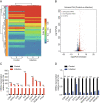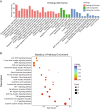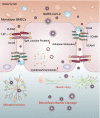SARS-CoV-2 productively infects human brain microvascular endothelial cells
- PMID: 35705998
- PMCID: PMC9198209
- DOI: 10.1186/s12974-022-02514-x
SARS-CoV-2 productively infects human brain microvascular endothelial cells
Abstract
Background: The emergence of the novel, pathogenic severe acute respiratory syndrome coronavirus 2 (SARS-CoV-2) has caused a global health emergency. SARS-CoV-2 is highly contagious and has a high mortality rate in severe patients. However, there is very limited information on the effect of SARS-CoV-2 infection on the integrity of the blood-brain barrier (BBB).
Methods: RNA-sequencing profiling was performed to analyze the transcriptomic changes in human brain microvascular endothelial cells (hBMECs) after SARS-CoV-2 infection. Bioinformatic tools were used for differential analysis. Immunofluorescence, real-time quantitative PCR, and Western blotting analysis were used to explore biological phenotypes.
Results: A total of 927 differentially expressed genes were identified, 610 of which were significantly upregulated while the remaining 317 were downregulated. We verified the significant induction of cytokines, chemokines, and adhesion molecules in hBMECs by SARS-CoV-2, suggesting an activation of the vascular endothelium in brain. Moreover, we demonstrated that SARS-CoV-2 infection could increase the BBB permeability, by downregulating as well as remodeling the intercellular tight junction proteins.
Conclusions: Our findings demonstrated that SARS-CoV-2 infection can cause BBB dysfunction, providing novel insights into the understanding of SARS-CoV-2 neuropathogenesis. Moreover, this finding shall constitute a new approach for future prevention and treatment of SARS-CoV-2-induced CNS infection.
Keywords: Blood–brain barrier; Human brain microvascular endothelial cells; Inflammatory response; Permeability; SARS-CoV-2.
© 2022. The Author(s).
Conflict of interest statement
The authors declare that they have no competing interests.
Figures







Similar articles
-
Recombinant human plasma gelsolin reverses increased permeability of the blood-brain barrier induced by the spike protein of the SARS-CoV-2 virus.J Neuroinflammation. 2022 Nov 24;19(1):282. doi: 10.1186/s12974-022-02642-4. J Neuroinflammation. 2022. PMID: 36434734 Free PMC article.
-
SARS-CoV-2 causes dysfunction in human iPSC-derived brain microvascular endothelial cells potentially by modulating the Wnt signaling pathway.Fluids Barriers CNS. 2024 Apr 8;21(1):32. doi: 10.1186/s12987-024-00533-9. Fluids Barriers CNS. 2024. PMID: 38584257 Free PMC article.
-
SARS-CoV-2 infects epithelial cells of the blood-cerebrospinal fluid barrier rather than endothelial cells or pericytes of the blood-brain barrier.Fluids Barriers CNS. 2023 Oct 24;20(1):76. doi: 10.1186/s12987-023-00479-4. Fluids Barriers CNS. 2023. PMID: 37875964 Free PMC article.
-
COVID-19 and Long COVID: Disruption of the Neurovascular Unit, Blood-Brain Barrier, and Tight Junctions.Neuroscientist. 2024 Aug;30(4):421-439. doi: 10.1177/10738584231194927. Epub 2023 Sep 11. Neuroscientist. 2024. PMID: 37694571 Review.
-
Cerebral microvascular complications associated with SARS-CoV-2 infection: How did it occur and how should it be treated?Biomed Pharmacother. 2022 Oct;154:113534. doi: 10.1016/j.biopha.2022.113534. Epub 2022 Aug 17. Biomed Pharmacother. 2022. PMID: 35994816 Free PMC article. Review.
Cited by
-
SARS-CoV-2-Induced Type I Interferon Signaling Dysregulation in Olfactory Networks Implications for Alzheimer's Disease.Curr Issues Mol Biol. 2024 May 10;46(5):4565-4579. doi: 10.3390/cimb46050277. Curr Issues Mol Biol. 2024. PMID: 38785545 Free PMC article.
-
SARS-Cov-2 Replication in a Blood-Brain Barrier Model Established with Human Brain Microvascular Endothelial Cells Induces Permeability and Disables ACE2-Dependent Regulation of Bradykinin B1 Receptor.Int J Mol Sci. 2025 Jun 10;26(12):5540. doi: 10.3390/ijms26125540. Int J Mol Sci. 2025. PMID: 40565006 Free PMC article.
-
Blood-brain barrier penetration of non-replicating SARS-CoV-2 and S1 variants of concern induce neuroinflammation which is accentuated in a mouse model of Alzheimer's disease.Brain Behav Immun. 2023 Mar;109:251-268. doi: 10.1016/j.bbi.2023.01.010. Epub 2023 Jan 20. Brain Behav Immun. 2023. PMID: 36682515 Free PMC article.
-
Omics-based analysis of mitochondrial dysfunction and BBB integrity in post-COVID-19 sequelae.Sci Rep. 2024 Dec 28;14(1):31016. doi: 10.1038/s41598-024-82180-6. Sci Rep. 2024. PMID: 39730725 Free PMC article.
-
The Effects of Viruses on Insulin Sensitivity and Blood-Brain Barrier Function.Int J Mol Sci. 2023 Jan 25;24(3):2377. doi: 10.3390/ijms24032377. Int J Mol Sci. 2023. PMID: 36768699 Free PMC article. Review.
References
MeSH terms
Grants and funding
- 2021YDF1800405/National Key Research and Development Program of China
- 2021YDF1800800/National Key Research and Development Program of China
- 32102749/National Natural Science Foundation of China
- 32122086/National Natural Science Foundation of China
- 2020FCA046/Emergency Science and Technology Project of Hubei Province
LinkOut - more resources
Full Text Sources
Medical
Miscellaneous

